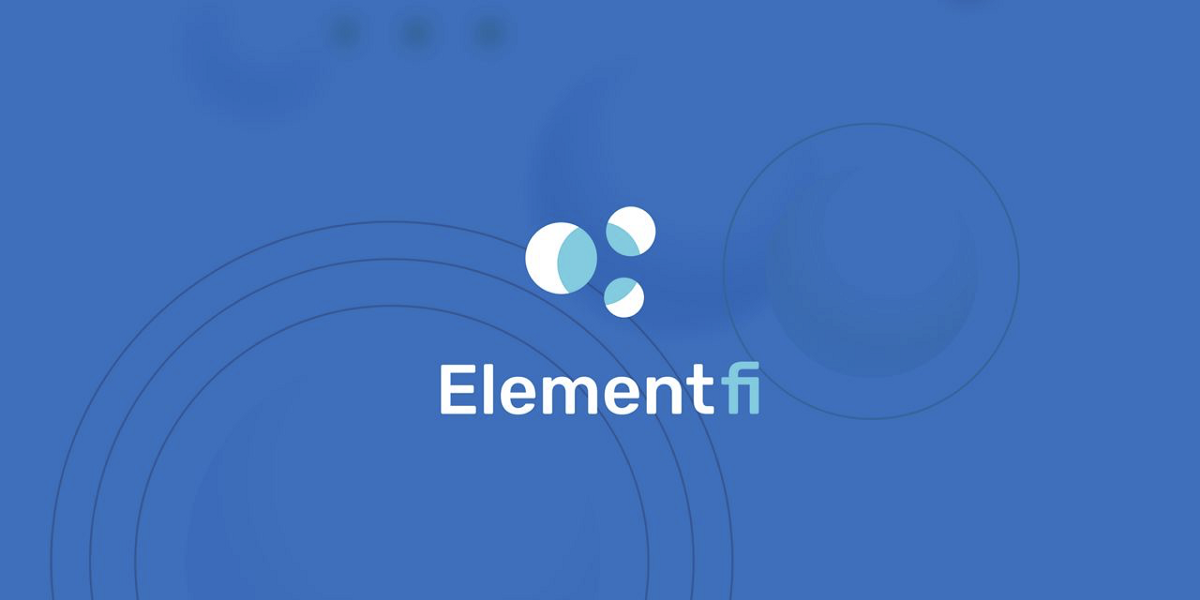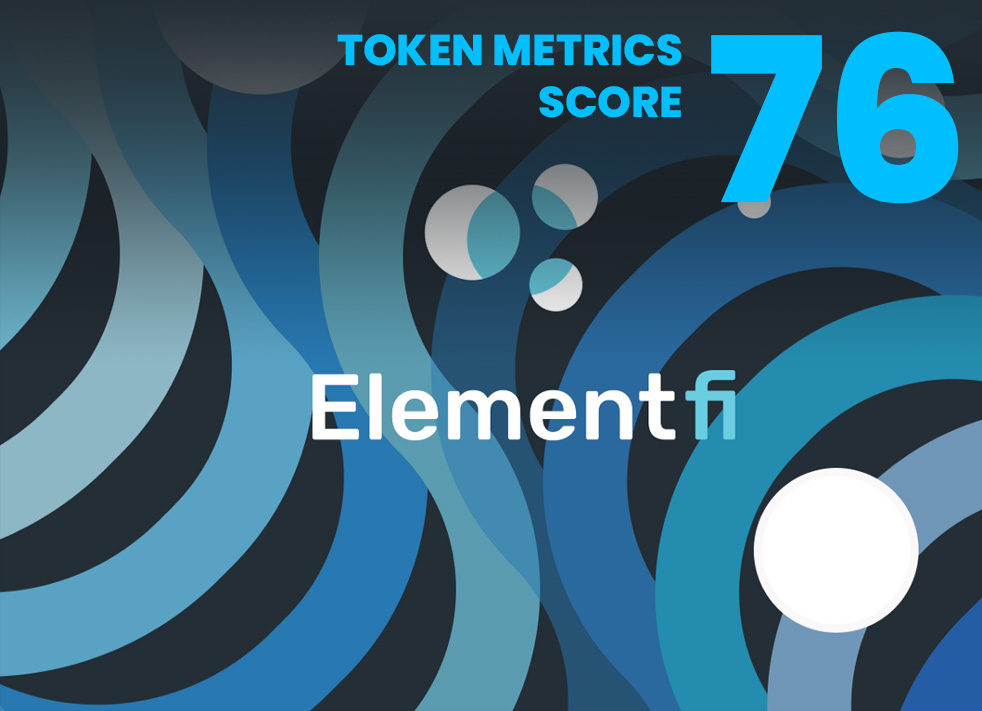Element Finance (ELFI): Capital Efficient Fixed Yield for DeFi | Deep Dive
Review Date: April 22, 2021
Today in DeFi assets can be deployed productively to earn a yield on your initial investment whether it be stablecoins or crypto assets. However, the yield you farm today is most often not the yield you farm tomorrow meaning yield is variable over time. This has several problems for users such as the costs and complexity of rebalancing their position to find the best yield in DeFi. Element Finance aims to solve this by providing a protocol for fixed yields meaning
when entering a position you know what yield you will get across a specified period of time. This removes the complexity of rebalancing and the associated protocol risk plus the problem of taxation. Elements backers, advisors, and teams are second to none plus the narrative of a new DeFi primitive to unlock capital efficiency with yields looks to be one of the strongest emerging protocols in the DeFi ecosystem.
The Current State of Yield in DeFi
DeFi users are constantly looking for the best strategies to deploy their crypto assets across protocols to earn the highest yield. Yearn Finance and its vault products have been extremely successful in this pursuit and now have $3B in total value locked deploying assets across the DeFi ecosystem to earn yield. However, the yield measured in annual percentage yield (APY) is variable across time meaning users are constantly rebalancing their position across protocols to maximize their yield which incurs transaction costs and new protocol risks via smart contract vulnerabilities.
Element Finance aims to solve yield variability by offering a fixed yield product at a lower rate but ensures that users know the exact APY they will receive when entering the position [1]. They do this by taking a yield generating position such as yETH which represents the Yearn Finance ETH vault deposit token, splitting it into two tokens: the principal token and the yield token. This allows the principal of the deposit to be used in other ways such as increased leveraged exposure to yield or some other means instead of being locked whilst still having exposure to a yield generating position.
Principal & Yield Tokens
Before we introduce how Element Finance is able to create fixed yield products we must understand a few definitions [1]:
Base Asset: A traditional crypto-asset such as BTC or ETH that is purchased from an exchange using fiat. Represents basic spot exposure.
Principal: A base asset that is locked in a protocol for a specified period of time that is redeemable for the base asset and the yield it has incurred.
Yield Token: Redemption value if the average yield generated across the term (time period) set for the principal.
Figure 1: Illustration of base asset, yToken, and Element’s Principal and Yield Token.
In order to understand how fixed yield works let’s take the following example. Alice has 10 ETH and wants a fixed yield on her ETH for the next year. Alice uses Element Finance to mint 11 eP: ETH Principal tokens with 10% APY and at the end of the year Alice can redeem her 11 eP: ETH Principal tokens for 11 ETH (10 ETH Principal & 1 ETH Yield). So instead of locking ETH into protocols with variable APYs that require constant rebalancing to maximize yield DeFi users will be able to take relatively stable yields on their crypto assets.
This is particularly important for Institutional adoption of DeFi as Institutions may not understand DeFi well enough to rebalance large amounts of capital and the associated smart contract risks of protocols plus the complication in taxation that would occur [2]. To put it simply, fixed yield is much more attractive than variable yield to Institutional money.
MakerDAO Example
Figure 2: Element unlocking principal to be sold at a discount to gain exposure to base assets.
Traditionally, if a DeFi user wanted to mint the DAI stablecoin via MakerDAO to use in yield farming they would lock up ETH at a collateralization ratio of 150%. This is very capital inefficient based on the amount of principal that needs to be locked and the opportunity cost it could incur.
The Element Finance solution would be to simply convert your ETH to DAI using a DEX. Proceed to mint yDAI at Yearn Finance and split the yVault token into the principal eP: yDAI and yield token eY: yDAI and sell the principal at a discount for ETH [1]. This means the user will still be earning yield on DAI but unlocks their principal to be used productively or to simply maintain their exposure to ETH.
There are many novel ways to use principal tokens as illustrated above. Another example would be instead of selling the principal for ETH, we can sell the principal for DAI and redeposit that DAI back into Element Finance to compound yield tokens which is akin to leveraging your yield. Unlocking the principal of yield positions provides so many opportunities to increase capital efficiency whilst maintaining a fixed yield. This results in driving the fixed yield APY higher meaning higher yields with less variability.
Principal Tokens & Capital Efficiency
A narrative that is beginning to emerge in DeFi as the space matures is increasing the capital efficiency of protocols. This means doing more with less capital. For example, Uniswap has a total value locked of around $7B and executes around $1-2B in volume per day. This is very capital inefficient as most of the liquidity stored on the AMM is not used for trading. Uniswap’s V3 aims to improve capital efficiency by providing the ability to liquidity providers to concentrate liquidity in a certain price range.
Figure 3: Uniswap liquidity relative to its daily transaction volume [3].
In respect to yield earning positions such as depositing ETH into a YEarn Finance vault, the underlying principle is locked until the user decides to redeem their vault tokens for the underlying principle and yield. This is very capital inefficient and the locked principal undergoes opportunity cost. Element Finance unlocks the underlying principle which can be deployed elsewhere whilst remaining exposed to the yield being generated.
Future Applications
When a new DeFi primitive is introduced to the market a whole new range of possibilities opens up for many protocols. This is what accelerates DeFi development; the power of composability. The possibilities of Element Finance are just being discovered with a few of the possibilities listed below plus many more listed in the construction paper:
- Ethereum 2.0: Any staking position outside of DeFi can be ported into Element Finance which can generate a fixed yield using the staking asset as collateral. This means that ETH staking on the beacon chain with Proof-of-stake consensus can have a fixed yield instead of the variable APY based on how much ETH is being staked. This will be very attractive to Institutions looking for a fixed yield on ETH.
- Principal tokens as collateral for borrowing: Principal tokens can be used as collateral with a low collateralization ratio as principal tokens converge on the price of the base asset (1 eP: yETH = 1 ETH). So instead of selling a PT on an AMM which will incur slippage, we can create a money market that uses PTs as collateral to borrow base assets.
- Liquid Fix Yield Markets: Another way to improve yield on an already yielding position such as yDAI (DAI deposited into Yearn DAI vault) is to deposit collateral into Element and mint corresponding principal and yield tokens. These new tokens can be used to provide liquidity on an AMM which the user will receive swap fees further increasing their yield whilst creating a liquid fixed yield market.
Figure 4: Depositing PTs and YTs into an AMM to generate additional yield via swap fees.
Team, Advisors & Investors
Element Finance recently raised $4.4m led by Andreasen Horrowitz, one of the most distinguished venture capital funds in Silicon Valley and Placeholder. Other prominent figures backing Element include Joseph Lubin of Consensys, Stani Kulechov of Aave, and Fernando Martinelli of Balancer. If these investors were not good enough the advisors for the protocol include Danny Ryan lead Ethereum 2.0 researcher, Mariano Conti previous lead smart contract developer of MakerDAO, and other prominent names in the Ethereum ecosystem.
Figure 5: Angel investors of Element Finance.
Following protocols with strong intellectual capital is always a way to bet on innovation and strong product-market fit. Element is an entirely new DeFi primitive that has the potential to unlock vast amounts of capital across the DeFi ecosystem and put it to work thereby increasing the capital efficiency of yield generating positions.
Summary
Element Finance is set to launch a new DeFi primitive which will offer stabilized yield products that will be very attractive to Institutional money entering the space. It will also increase capital efficiency via unlocking principal tokens which allow users to further increase their yield with leveraged exposure or deploy capital in other sophisticated ways. Backed by some of the best venture capital firms in the space, the best angel investors from the DeFi ecosystem, and prominent researchers in the Ethereum protocol layer, Element Finance is a powerhouse for increasing capital efficiency for many DeFi protocols. The protocol is set to launch primarily building on YFI yield earning positions and includes BTC, ETH, USDC, and DAI.
REFERENCES
- https://paper.element.fi/#6-building-on-top-of-the-element-protocol
- https://medium.com/element-finance/fixed-rate-interest-markets-a-casual-us- ers-journey-through-fixed-rate-interest-using-element-50f420df1859
- https://www.coindesk.com/andreessen-horowitz-leads-4-4m-round-in-defis-el- ement-finance
- https://info.uniswap.org/home
DISCLAIMER
Token Metrics Media LLC is a regular publication of information, analysis and commentary focused especially on blockchain technology and business, cryptocurrency, blockchain-based tokens, market trends, and trading strategies.
Token Metrics Media LLC does not provide individually tailored investment advice and does not take a subscriber’s or anyone’s personal circumstances into consideration when discussing investments; nor is Token Metrics Media LLC registered as an investment adviser or broker-dealer in any jurisdiction.
Information contained herein is not an offer or solicitation to buy, hold or sell any security. The Token Metrics team have advised and invested in many blockchain companies. A complete list of their advisory roles and current holdings can be viewed here: https://tokenmetrics.com/disclosures/





